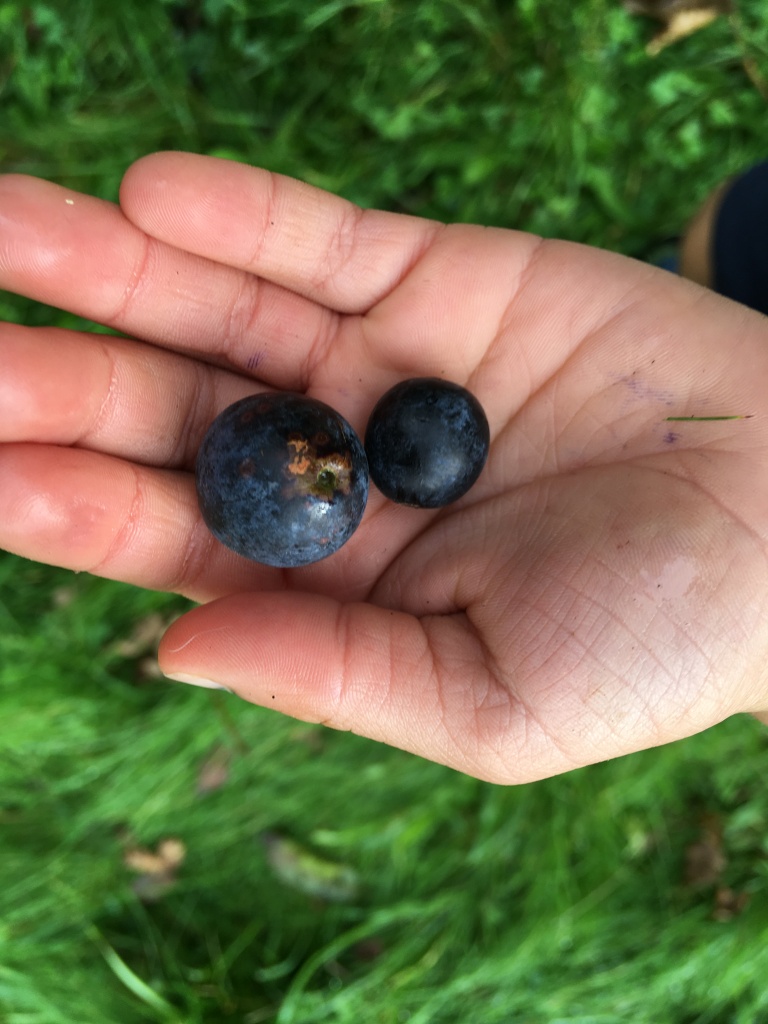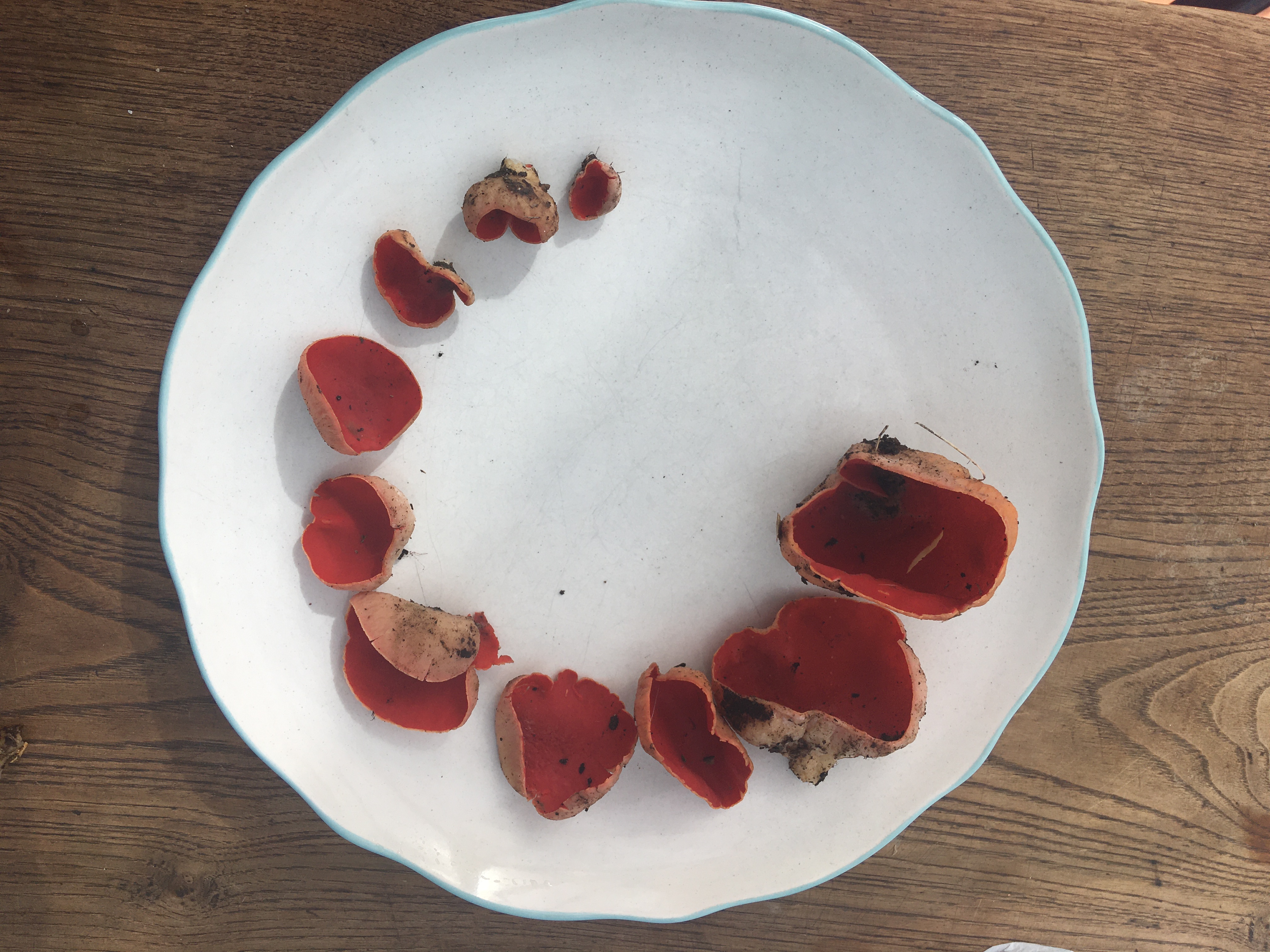
The year’s final pickings offer plenty for the larder. Sloes and rosehips can be made into liquors, cordials, jellies, jams, syrups, cheeses, and, in the case of the hips, a health-giving deep red tea. And there is an abundance of nuts to gather, process and store to tide you over the dead of winter – provided you have the patience of, or even better are, a squirrel.
There is a long hedgerow near our house of what looks like blackthorn, the bush that produces sloes. When I went to collect the fruit last year, I realised from the bigger, fleshier fruit, and the thorn-less branches that rather than blackthorn it must be something slightly closer on the family tree to the domesticated plum. Exactly what it is though remains a matter of some contention. Wild plum isn’t quite right as it is closer to a sloe than a plum, with almost identical blue-black skin and a certain degree of sloe-like astringency. It could perhaps be called a bullace, although for some that is just another name for a wild plum, or even a gage. Given that there are sloes growing in the same hedgerow slightly further up the hill, I wonder if it is a sub-species all of its own – a plum of some description that has crossed with the blackthorn to produce this small, plump, purple fruit. Whatever it is, the boys love the ripe, slightly wrinkled ones straight off the bush, and it makes a delicious jam. As is often the case, collecting is the easy part. The four kilograms of fruit we picked in half an hour took me one evening to clean of stems and leaves, one evening to de-stone (after boiling the fruit to soften it), and a morning to boil into jam and bottle.

We awoke on 1st November to find the grass white and crunchy for the first time since May. The first frost heralds the end of the foraging year, but it is also the best time to harvest sloes and rosehips. The freeze blets them – the words you learn as a forager – which means they become softer and sweeter. Rosehips in fact harden as they ripen. Soft rosehips are either not yet ripe or not quite right, and are left on the bush for the birds; it is the shinier, darker hardened hips only that we pick. So perhaps in this case bletting refers only to their becoming sweeter. It is possible to mimic the action of a frost by putting them in the freezer overnight, and I’ve done this once when we all had terrible colds in a mild October and I wanted to dose everyone up with rosehip syrup. Really though I’m sure it is best to wait for that first frost because this is also the time that both fruits are fully ripe.

The most popular use for sloes is sloe gin – steeping sloes in a sweetened gin, ideally for over a year, to make a dark purple liquor. You could in theory use sloes to make jam, as with their wild plum relatives, with lots of sugar and most probably a huge amount of elbow grease to remove all those tiny stones. Better still would be a jelly where you sieve off the pulp and stones. The only way of preserving them without large amounts of sugar, as far as I know, is to ferment them in brine Japanese-style.
Rosehips, I’ve been told many a time by the older residents of our village, had two principal uses. Children collected them to make an itching powder from the pale hairy fluff inside the hips which they would then put down their friends’ pants. And during the war rosehips were made into a syrup designed to prevent vitamin C deficiency at a time when food including fruit was strictly rationed. Now that we can all buy pesticide-treated oranges in the supermarket, and Vitamin C tablets in Boots, there is no need for rosehip syrup – which means there’s plenty of rosehips for the birds as well as people like us who still collect them. The itching value of rosehips too has long been forgotten by today’s children. Certainly, any kitchen preparation of rosehips needs to factor in the removal of those itchy hairs. For a syrup or jelly you can just filter them out when you strain the liquid. For dried rosehips, you dry them whole (no need to top and tail them, despite the recommendations in most recipes), pound them in a pestle and mortar and then filter it – the pale fluff falls through the sieve and can be thrown away, or put down someone’s trousers, and what you are left with can be used to make tea.

Nuts and fruit are both the culmination of all that hard work these lovely plants put into producing the next generation, but these seed vehicles vary wildly. At one end of the spectrum you have berries – easy to pick and easy to eat, but calorie-light and with no shelf-life (unless you preserve them). At the other you have nuts – often difficult to pick and difficult to process, but packed with kilojoules of energy and lasting forever. If we leave aside the interesting topic of acorns – which some people do still collect and process with great labour to create an edible foodstuff – the main harvestable nuts in this country are those of the beech, hazel, walnut, pine and sweet chestnut trees.
We have always arrived too late to the foraging table when it comes to beech and hazelnuts. Squirrels love both and will always best human foragers in any nut-gathering competition. I have though tasted hazelnuts gathered by a friend and they are delicious, much sweeter than the ones you buy, so next year I hope to wrestle my fair share from our furry friends. Wild walnut trees are hard to come by nor have I attempted to collect pine nuts – although I’m reliably informed that the labour involved make commercially sold pine nuts seem cheap at the price. That leaves us with sweet chestnuts.
Chestnuts spelt two sacred winter traditions in my childhood: the autumn conker fight and the Christmas roasted chestnut. I’m not sure what has happened to conker fights. Either they are not nearly as exciting as football cards or Fortnight, or schools banned them for being too violent. Which is a pity as the lure of collecting conkers was a surefire way of getting us children out for long walks on rainy October days. As far as I can tell the horse chestnut, which gives us conkers, isn’t even related to the sweet chestnut, which gives us the edible chestnuts. The nuts though are similar: both are collected from spiky cases that fall to the ground and must at times be prised open, and both are shiny, hard and dark brown. The conker, for all its freshly opened beauty, is poisonous. The sweet chestnut, which used to be roasted on street stalls in London and sold by the paper bag, is delicious. Sweet chestnuts may no longer be available on the street but they are still a popular posh ingredient, Jamie Oliver style, and no doubt Waitrose stock them.

As ever in this country those of us mad enough to gather rather than purchase are so few and far between we have plenty of trees to choose from. We found an abundance of sweet chestnuts just in the car parks of two local forest areas, and took them home to roast. Rolling over them with a (shoe-d) foot is the best way to break open their spiky case. Each case tends to contain two tiny end nuts and one big central one, which is the one with the meat on it. You can then pierce and roast them with a griddle on an open flame, as our foraging partners did here, or rather more boringly in the oven as I did. Covering them once roasted should make it easier to remove the shell, especially if you peel them when they’re still warm. They taste just as good as my 8-year-old self remembers.








































